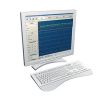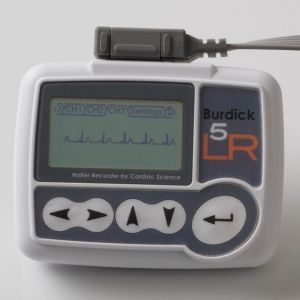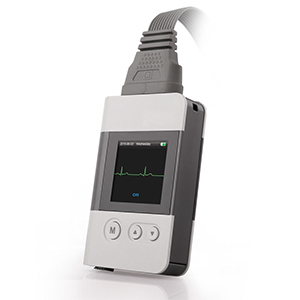Cube Holter Software For Click & Walk400 Recorders
Cubeholter is the complete solution to manage Holter ECG tests.
Cubeholter combines all the typical procedures for the Holter test in a single application: from recorder management to downloading the test to a PC and automatically archiving it, from automatic analysis and review to printing out the final document and exporting it in electronic format.
Cubeholter can operate as a single workstation, or the database can be shared with other networked cube workstations.
| Holter Accessories |
|---|
Features
The main characteristics of Cubeholter are:
User Interface
Cubeholter makes the most of the graphic potential of Windows, guiding even inexpert users through the correct execution of all phases of the Holter test. Using menus, dedicated keys and guided procedures, working with Cubeholter is extremely practical and fast.
Cubeholter consists of a several windows which can be used to monitor all program features at the same time: from simply displaying the trace in various formats to validating the automatic analysis and printing out the final document.
Cubeholter has five main windows, each designed to direct the attention of the operator to a particular aspect of the test:
- the RR window displays the RR tachogram, the dedicated trends for each type of arrhythmia. And offers an overall view of the test thanks to the colour coding and combined use and display of the ECG trace in compact, zoom or superimposed mode;
- the families window presents the results of the morphological analysis, grouping all complexes found during the Holter recording into classes. It thus represents the ideal tool for analysis editing, thanks to its speed and efficacy;
- the events window lists all the episodes detected, indicating the number and always allowing the user to evaluate them in context;
- the ST window focuses the operator’s attention on ST and QT segment analysis. All the leads recorded may be displayed singly or together;
- the report window allows the user to write conclusions, configure the final document for printing, or select one of the configurations saved in the system and the proceed to print out the document. It is also possible to export the document to be printed out in electronic format, or to attach it automatically to an e-mail.
A characteristic common to all the windows is their direct interaction with the ECG trace displayed on the screen: the change, enter or delete beat functions are always available, and may be applied to individual beats or groups of beats, as can the prebook printout, or direct printout functions. Changes may be made to the analysis using the mouse or dedicated keyboard keys.
To speed up writing of the final report, each window is also provided with a free text area which can automatically be included in the final conclusions of the printed document.
Use profile
The operator can choose to use all the displays available in Cubeholter or can select, to use only those that best meet his or her requirements and approach.
Automatic Analysis
The efficiency and performance of the analysis algorithms, together with the calculation power of the latest generation of PCs, guarantee the accuracy of the analysis and allow the program to perform beat-beat analysis very quickly.
Automatic analysis is based on classifying anomalies into event types and morphological families.
Cubeholter executes the following analyses automatically:
- arrhythmia analysis;
- family analysis;
- independent ST and QT analysis for 3/12 channels;
- analysis of variability in the time domain,
- pacemaker analysis;
- atrial fibrillation analysis.
From the first time the test is opened, cubeholter presents a complete and detailed report on the events detected.
The automatic analysis algorithms are the fruit of over twenty years’ experience in analysing the Holter test, and of continual research for innovative solutions that perform the analysis algorithms have been validated on the MIT database.
All the analysis, printout and display parameters can be customised and saved as system configurations, or a particular configuration can be defined for a single test.
Additional software modules for analysis of RR variability in the frequency domain, and Late Potentials analysis are available as advanced options.
Saving tests
Cubeholter includes a dedicated database in which acquired tests can be saved and organised.
Cubeholter places the patient at the centre of the system, creating a virtual clinical record in which all the tests performed by cube workstations are automatically saved.
Managing tests
Cubeholter offers a system of predefined views of the database, accessed by dedicated icons on the toolbar: so the operator can quickly access the list of tests to report on, and read and sign each test. The program also includes a long term archiving function for the database, which allows tests that have already been analysed to be transferred to an external support (CD, DVD, etc.), maintaining the patient data and overall data on the archived test available online in the database.
Cubeholter also allows advanced searches to be made using the patient data, test or acquisition device as search parameters.
Management of test preparation and downloading procedures
Cubeholter offers innovative management of the procedures to prepare tests and download them to the PC. The operator can use guided procedures to successfully and efficiently prepare both the recorder and the downloading of the test to the PC, managing the patient data correctly, entering the indications and treatment, programming the duration of the test and programming for pacemaker detection if required.
Sharing the database with other cube stations
Cubeholter was designed with the capability to share its database with other cube workstations. This feature can be used to optimise work in a clinic or ward according to the specific clinical requirements of the individual physician. For example, workstations can be dedicated to downloading tests, and others to their analysis, or to the execution of different diagnostic techniques such as stress tests and rest ECGs.
Add a review
You must be logged in to post a review.









Reviews
There are no reviews yet.